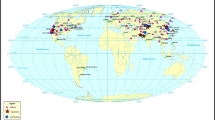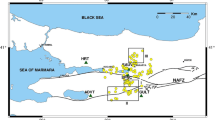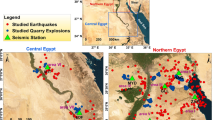Abstract
In Soma Region, located in the western part of Turkey, both tectonic and anthropogenic source type of events are identified in earthquake catalogues by various seismology centers. Especially because of the low-magnitude quarry blasts, mistakes can be made in seismic catalogs in terms of source type, which can be further complicated by similar magnitude earthquakes. With this regard, the vertical component seismograms of 445 seismic events with a magnitude of Ml ≤ 2.5 recorded at the station SOMA, operated by Boğaziçi University Kandilli Observatory and Earthquake Research Institute Regional Earthquake–Tsunami Monitoring Center (KOERI–RETMC), were analyzed. First, two statistical analyses (Linear and Quadratic Discriminant Functions–LDF/QDF) were applied for amplitude ratio and complexity methods for 345 waveforms that have the same source types in both KOERI–RETMC catalogs and the first manual determination. The accuracies of the statistical approaches are varied between 87.25% and 97.39% and the better statistical classifier is the QDF for complexity method. Then, using the values obtained from two methods together, tree-based machine learning (ML) classifiers called as Random Forest (RF), Gradient Boosting (GB) and Support Vector Machine (SVM) were applied to the same data set. All classifiers provided as 100% success rate for quarry blasts’ recordings, while earthquakes are categorized by RF, GB and SVM with 97.1%, 95.8% and 92.8%, respectively. Each ML algorithms were applied to the other 100 data identified as quarry blast on KOERI–RETMC catalogs but determined to be suspicious source types on first manual determination. Regarding to the outperforming RF and GB algorithms, the quarry blast recordings have just been reached as 53 and 55, respectively. Considering the accuracies of the ML algorithms in the testing and training data set, the source types of the low magnitude seismic events that are registered in the catalogs should be re-evaluated and refined in Soma Region using the station SOMA.







Similar content being viewed by others
Availability of data and materials
The data sets are freely available from the database of Boğaziçi University Kandilli Observatory and Earthquake Research Institute Regional Earthquake–Tsunami Monitoring Center (KOERI–RETMC) and the corresponding author.
References
Akbaş B, Akdeniz N, Aksay A, Altun İE Balcı V, Bilginer E, Bilgiç T, Duru M, Ercan T, Gedik İ, Günay Y, Güven İH, Hakyemez HY, Konak N, Papak İ, Pehlivan Ş, Sevin M, Şenel M, Tarhan N, Turhan N, Türkecan A, Ulu Ü, Uğuz MF, Yurtsever A (2011) 1:1.250.000 ölçekli Türkiye Jeoloji Haritası. Maden Tetkik ve Arama Genel Müdürlüğü Yayını, Ankara, Türkiye (in Turkish)
Akiba T, Sano S, Yanase T, Ohta T, Koyama M (2019) Optuna: A next-generation hyperparameter optimization framework. In: Proceedings of the 25th ACM SIGKDD international conference on knowledge discovery & data mining. p 2623–2631
AllamehZadeh M (2011) Discrimination analysis of earthquakes and man-made events using ARMA coefficents determination by artificial neural networks. Nat Resour Res 20(4):367–375
Arai N, Yosida Y (2004) Discrimination by short-period seismograms. International Institute of Seismology and Earthquake Engineering, Building Research Institute (IISEE) Lecture Note, Global Course, Tsukuba, Japan, p 10
Badawy A, Gamal M, Farid W, Soliman MS (2019) Decontamination of earthquake catalog from quarry blast events in northern Egypt. J Seismol 23(6):1357–1372
Baumgardt DR, Young GB (1990) Regional seismic waveform discriminants and case-based event identification using regional arrays. Bull Seism Soc Am 80(6B):1874–1892
Beck SL, Wallace TC (1997) Broadband seismic recordings of mining explosions and earthquakes in South America. University of Arizona, Department of Geosciences, Arizona, USA
Budakoglu E, Horasan G (2018) Classification of seismic events using linear discriminant function (LDF) in the Sakarya region, Turkey. Acta Geophys 66(5):895–906
Chen Y, Saad OM, Savvaidis A, Chen Y, Fomel S (2022) 3D microseismic monitoring using machine learning. J Geophys Res: Solid Earth 127(3):e2021JB023842
Chen Y, Savvaidis A, Fomel S, Saad OM, Chen Y (2023) RFloc3D: a machine learning method for 3D microseismic source location using P-and S-wave arrivals. IEEE Trans Geosci Remote Sens. https://doi.org/10.1109/TGRS.2023.3236572. (Art no. 5901310)
Cortes C, Vapnik V (1995) Support-vector networks. Mach Learn 20:273–297
Dong L, Wesseloo J, Potvin Y, Li X (2016) Discrimination of mine seismic events and blasts using the fisher classifier, Naive Bayesian classifier and logistic regression. Rock Mech Rock Eng 49(1):183–211
Dysart PS, Pulli JJ (1990) Regional seismic event classification at the NORESS array: seismological measurements and the use of trained neural networks. Bull Seism Soc Am 80(6B):1910–1933
Emre Ö, Duman TY, Özalp S, Elmacı H, Olgun Ş, Şaroğlu F (2013) 1/1.250.000 Ölçekli Türkiye Diri Fay Haritası. Maden Tetkik ve Arama Genel Müdürlüğü Özel Yayınlar Serisi, Ankara, Türkiye (in Turkish)
Fisher RA (1936) The use of multiple measurements in taxonomic problems. Ann Eugen 7(2):179–188
Gibbons SJ, Ringdal F (2011) Seismic monitoring of the North Korea nuclear test site using a multichannel correlation detector. IEEE Trans Geosci Remote Sens 50(5):1897–1909
Gitterman Y, Shapira A (1993) Spectral discrimination of underwater explosions. Isr J Earth Sci 42(1):37–44
Gitterman Y, Pinsky V, Shapira A (1998) Spectral classification methods in monitoring small local events by the Israel seismic network. J Seismol 2(3):237–256
Goldstein P, Dodge D, Firpo M, Minner L (2003) SAC2000: Signal processing and analysis tools for seismologists and engineers. In: Lee WHK, Kanamori H, Jennings PC, Kisslinger C (eds) The IASPEI international handbook of earthquake and engineering seismology. Academic Press, London, pp 1613–1614
Horasan G, Güney AB, Küsmezer A, Bekler F, Öğütçü Z, Musaoğlu N (2009) Contamination of seismicity catalogs by quarry blasts: an example from Istanbul and its vicinity, northwestern Turkey. J Asian Earth Sci 34(1):90–99
Hunter JD (2007) Matplotlib: a 2D graphics environment. Comput Sci Eng 9(3):90–95
Iban MC, Şentürk E (2022) Machine learning regression models for prediction of multiple ionospheric parameters. Adv Space Res 69(3):1319–1334
Kartal ÖF, Horasan G (2011) Trabzon ve civarındaki deprem ve patlatma verilerinin birbirinden ayırt edilmesi. SAÜ Fen Bilimleri Dergisi 15(1):68–74 (in Turkish)
Kekovalı K, Kalafat D, Deniz P (2012) Spectral discrimination between mining blasts and natural earthquakes: Application to the vicinity of Tunçbilek mining area, Western Turkey. Int J Phys Sci 7(35):5339–5352
Kim S, Lee K, You K (2020) Seismic discrimination between earthquakes and explosions using support vector machine. Sensors 20(7):1879
Koch K, Fäh D (2002) Identification of earthquakes and explosions using amplitude ratios: the Vogtland area revisited. Pure Appl Geophys 159(4):735–757
Kuyuk HS, Yildirim E, Dogan E, Horasan G (2011) An unsupervised learning algorithm: application to the discrimination of seismic events and quarry blasts in the vicinity of Istanbul. Nat Hazards Earth Syst Sci 11(1):93–100
Kuyuk HS, Yildirim E, Dogan E, Horasan G (2012) Application of k-means and Gaussian mixture model for classification of seismic activities in Istanbul. Nonlin Process Geophys 19(4):411–419
Kuyuk HS, Yildirim E, Dogan E, Horasan G (2014) Clustering seismic activities using linear and nonlinear discriminant analysis. J Earth Sci 25(1):140–145
Li XB, Shang XY, Peng K (2017) Classification of seismic events and quarry blasts using singular value decomposition and support vector machine. J Test Eval 45(1):140–151
Li Z, Meier MA, Hauksson E, Zhan Z, Andrews J (2018) Machine learning seismic wave discrimination: application to earthquake early warning. Geophys Res Lett 45(10):4773–4779
Linville L, Pankow K, Draelos T (2019) Deep learning models augment analyst decisions for event discrimination. Geophys Res Lett 46(7):3643–3651
Liu X, Ren T, Chen H, Chen Y (2021) Classification of tectonic and non-tectonic seismicity based on convolutional neural network. Geophys J Int 224(1):191–198
MATLAB Release (2015) The MathWorks, Inc, Natick, Massachusetts, United States
Miao F, Carpenter NS, Wang Z, Holcomb AS, Woolery EW (2020) High-accuracy discrimination of blasts and earthquakes using neural networks with multiwindow spectral data. Seismol Res Lett 91(3):1646–1659
Nakano M, Sugiyama D, Hori T, Kuwatani T, Tsuboi S (2019) Discrimination of seismic signals from earthquakes and tectonic tremor by applying a convolutional neural network to running spectral images. Seismol Res Lett 90(2A):530–538
Öğütçü Z, Horasan G, Kalafat D (2011) Investigation of microseismic activity sources in Konya and its vicinity, central Turkey. Nat Hazards 58(1):497–509
Renouard A, Maggi A, Grunberg M, Doubre C, Hibert C (2021) Toward false event detection and quarry blast versus earthquake discrimination in an operational setting using semiautomated machine learning. Seismol Soc Am 92(6):3725–3742
Saad OM, Shalaby A, Sayed MS (2019) Automatic discrimination of earthquakes and quarry blasts using wavelet filter bank and support vector machine. J Seismol 23(2):357–371
Saad OM, Solima MS, Chen Y, Amin AA, Abdelhafiez HE (2022a) Discriminating earthquakes from quarry blasts using capsule neural network. IEEE Geosci Remote Sens Lett 19:1–5 (Art no. 8029605)
Saad OM, Chen Y, Trugman D, Soliman MS, Samy L, Savvaidis A, Chen Y (2022b) Machine learning for fast and reliable source-location estimation in earthquake early warning. IEEE Geosci Remote Sens Lett 19:1–5 (Art no. 8025705)
Schölkopf B, Sung KK, Burges CJC, GirosiF NP, Poggio T, Vapnik V (1997) Comparing support vector machines with Gaussian kernels to radial basis function classifiers. IEEE Trans Signal Process 45:2758–2765
Sertçelik F, Başer O (2010) Güney Ege Bölgesi’nde yapay ve doğal kaynaklı titreşimlerin ayırt edilmesi. Yerbilimleri 31(3):233–245 (in Turkish)
Sertçelik F, Yavuz E, Birdem M, Merter G (2020) Discrimination of the natural and artificial quakes in the eastern Marmara region, Turkey. Acta Geod Geophys 55(4):645–665
Shang X, Li X, Morales-Esteban A, Chen G (2017) Improving microseismic event and quarry blast classification using artificial neural networks based on principal component analysis. Soil Dyn Earthq Eng 99:142–149
Smola AJ, Schölkopf B (2004) A tutorial on support vector regression. Stat Comput 14:199–222
Su F, Aki K, Biswas NN (1991) Discriminating quarry blasts from earthquakes using coda waves. Bull Seism Soc Am 81(1):162–178
Tan A, Horasan G, Kalafat D, Gülbağ A (2021) Discrimination of earthquakes and quarries in the Edirne district (Turkey) and its vicinity by using a linear discriminate function method and artificial neural networks. Acta Geophys 69(1):17–27
Tang L, Zhang M, Wen L (2020) Support vector machine classification of seismic events in the Tianshan orogenic belt. J Geophys Res Solid Earth 125(1):e2019JB018132
Tian X, Wang M, Zhang X, Wang X, Sheng S, Lü J (2022) Discrimination of earthquake and quarry blast based on multi-input convolutional neural network. Chin J Geophys 65(5):1802–1812
Ursino A, Langer H, Scarfì L, Di Grazia G, Gresta S (2001) Discrimination of quarry blasts from tectonic microearthquakes in the Hyblean Plateau (Southeastern Sicily). Ann Geophys 44(4):703–722
Vapnik VN (2000) The nature of statistical learning theory, 2nd edn. Springer, New York, NY. https://doi.org/10.1007/978-1-4757-3264-1
Wessel P, Smith WHF (1998) New, improved version of generic map** tools released. EOS Trans Am Geophys 79(47):579
Wüster J (1993) Discrimination of chemical explosions and earthquakes in central Europe-a case study. Bull Seism Soc Am 83(4):1184–1212
Yavuz E (2022) Refining micro-seismic catalogs around Seydişehir, Turkey. Ann Geophys. https://doi.org/10.4401/ag-8736
Yavuz E, Sertçelik F, Livaoğlu H, Woith H, Lühr BG (2019a) Discrimination of quarry blasts from tectonic events in the Armutlu Peninsula, Turkey. J Seismol 23(1):59–76
Yavuz E, Sertçelik F, Livaoğlu H, Irmak TS (2019b) Gaziantep-Kahramanmaraş Bölgesinde meydana gelen deprem ve taş ocağı patlatmalarının zaman ve frekans ortamı yöntemleri ile sınıflandırılması. Bitlis Eren Üniversitesi Fen Bilimleri Dergisi 8(2):642–651 (in Turkish)
Yıldırım E, Gülbağ A, Horasan G, Doğan E (2011) Discrimination of quarry blasts and earthquakes in the vicinity of Istanbul using soft computing techniques. Comput Geosci 37(9):1209–1217
Yılmaz Ş, Bayrak Y, Çınar H (2013) Discrimination of earthquakes and quarry blasts in the eastern Black Sea region of Turkey. J Seismol 17(2):721–734
Acknowledgements
The seismic waveform data reached from T.R. Boğaziçi University Kandilli Observatory and Earthquake Research Institute Regional Earthquake–Tsunami Monitoring Center (KOERI–RETMC). The figures are prepared using the GMT software (Wessel and Smith 1998), SAC (Goldstein et al. 2003), MATLAB 2015, Matplotlib library (Hunter 2007), Optuna (Akiba et al. 2019) and Google Earth Pro. The authors thank Prof. Olaf Kolditz (editor) and anonymous reviewers for their crucial and helpful comments.
Funding
Not applicable.
Author information
Authors and Affiliations
Contributions
All authors contributed to the study conception and design. Data are obtained and prepared by EY. Data analyses were performed by EY, MCI, EA. The first draft of the manuscript was written by EY and MCI and all authors commented on previous versions of the manuscript. All authors read and approved the final manuscript.
Corresponding author
Ethics declarations
Conflict of interest
The authors have no relevant financial or non-financial interests to disclose.
Ethical approval and consent to participate
Not applicable.
Consent for publication
We give the consent for the publication that can include all figures and tables within the text to be published in the Environmental Earth Sciences.
Additional information
Publisher's Note
Springer Nature remains neutral with regard to jurisdictional claims in published maps and institutional affiliations.
Rights and permissions
Springer Nature or its licensor (e.g. a society or other partner) holds exclusive rights to this article under a publishing agreement with the author(s) or other rightsholder(s); author self-archiving of the accepted manuscript version of this article is solely governed by the terms of such publishing agreement and applicable law.
About this article
Cite this article
Yavuz, E., Iban, M.C. & Arpaz, E. Identifying the source types of the seismic events using discriminant functions and tree-based machine learning algorithms at Soma Region, Turkey. Environ Earth Sci 82, 265 (2023). https://doi.org/10.1007/s12665-023-10946-8
Received:
Accepted:
Published:
DOI: https://doi.org/10.1007/s12665-023-10946-8




